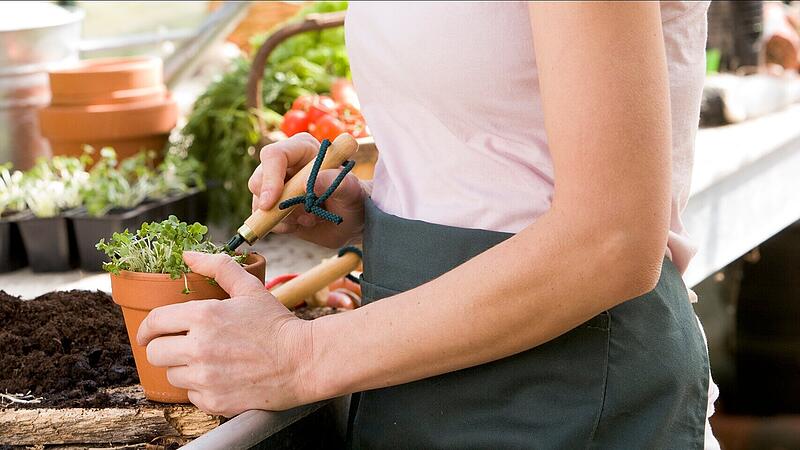Image: Colourbox

Image: Alois Litzlbauer

Image: plo

Image: colourbox
Everything is earlier, but you shouldn’t be tempted too much. The nights can still be quite cold. Nevertheless – now it’s time for sowing, and here are the most important cornerstones for a successful “infancy” of the plants!
If you look at the seed shelves in nurseries, garden centers and hardware stores, you will see how endless the range of varieties is. A decision is often difficult.
- Old seeds or hybrid varieties? “Old” seeds have been tried and tested many times and are offered by many companies. The “Noah’s Ark” is one of the pioneers. But what does “hybrid variety” mean? The so-called F1 seeds are plants with special properties such as powdery mildew resistance, compact growth, etc. They are not genetically modified, but they cannot be propagated using self-harvested seeds. The “old” seeds, on the other hand, are seed-proof and can be harvested again and again.
- Tomato and basil: Tomato tomatoes are now on the windowsill if you can’t cultivate them in a glasshouse. Basil for the windowsill can also be sown, as can some summer flowers.
- Radishes, carrots: In the garden there is a wide range: radishes, carrots, lettuce, chard or many herbs such as parsley and dill.
- The perfect earth: The sowing soil for the pre-culture on the windowsill should be loose, permeable and retains water well. Normal ready-made soil contains too much fertilizer; the tender roots of the seedlings would usually not survive. You should always buy sowing soil fresh, but you can also mix it yourself: garden soil (from molehills) mixed with leaf mold compost, sand and/or perlite (this is an insulating material made of stone). It is best to sterilize the soil first by filling it into a metal pot, placing it in the oven covered with a lid and steaming it at 90 degrees for 30 minutes.
- Spring awakening: In order for the seeds to awaken, warmth and moisture are essential. You can therefore first place the seed trays and pots on a radiator covered with glass plates. Water well and never let it dry out. Once the seeds have germinated, place them in the light. Water for better growth with microorganisms. If you sow outdoors, slurry the seed grooves with a watering can and then cover them with fleece. The warmer it is, the more light the plants need, otherwise they will “cure,” as gardeners call linear growth. Light green leaves are also a sign of too little light. Therefore, on sunny spring days, always harden off outdoors during the day. At the beginning, however, protect it from burning with fleece. Watch out! There are seeds that need light to germinate – basil, for example, must not be covered with soil.
- This is how pricking works: If the plants are too close together, you have to prick them out, i.e. separate them. This is how you do it: Use a wooden stick to loosen the plants in the seed tray, then only pick up the small cotyledons with your fingers (not the stems) and place them in a larger tray or small pots. Shorten particularly long roots with your fingernail so that strong branching occurs. Cleanliness is the best prerequisite for success when sowing. Always clean bowls, pots and tools well. Water with microorganisms, horsetail extract and always ventilate the bowls well. As much as they love high humidity, there can be no stuffy air. The “babies” need a lot of attention. They must not be too wet or too dry in the seed trays; there are snails lurking outdoors that are after the delicate leaves. Set up and collect organic snail pellets or barriers. Don’t forget to write name tags, otherwise there will be a big mess.

Image: Alois Litzlbauer
Garden questions
We’ve never gotten nice big celery bulbs. What are we doing wrong?
Celery is extremely sensitive to cold for the first time, so wait until there are no more cold nights. Then add a small pinch of salt to the planting hole (originally a seaside plant) and then fertilize with liquid weekly.
I want to hang some nesting boxes this year. When is the last time for this and how far should the distance be?
It’s about time! The birds are also active early due to the mild weather. The sooner you hang the nesting boxes, the better. Be careful that cats cannot reach the boxes, so place them at least three meters high. The distance between the boxes should be five to ten meters, depending on the food available in the garden.

Image: plo
Plant of the week: No spring without primroses
The colorful flowers of primroses are now dominant in garden centers. In recent years in particular, many new varieties have been bred that have two advantages. On the one hand, they can withstand the heat in the rooms a little better, but on the other hand, they have become more frost-resistant and grow in the garden for many years after being planted out. The general rule for primroses in pots is to always keep them moist, never place them in direct sunlight and, if possible, keep them in the cool overnight. Plants with flowers like wild cowslips and pastel colors are particularly popular.
Garden calendar: What can go outdoors now?
Repotting: All houseplants can now be repotted. In particularly mild areas, harden off the balcony flowers on sunny days, but do not immediately place them in the blazing sun.
Go outdoors: Some potted plants can also go out: oleander, laurel, some palm trees and olives can tolerate light frost. Everyone else has to go back into the house when temperatures are below zero degrees.
Cucumbers and zucchini are only grown in warm weather towards the end of April because they grow very quickly. However, these sensitive plants only come outdoors after the ice men in mid-May.
Lettuce can be planted outdoors from the beginning of March, as can kohlrabi. Radishes, lettuces and herbs are sown.
Spray fruit trees from time to time with horsetail tea and microorganisms; this strengthens the leaves and protects them from fungal diseases. Hang up an earwig house to protect against aphids from mid-April (clay pot on a string, into which wood wool is stuffed and which rests directly on the trunk, is the “bedroom” for earwigs).
Snails: Watch out for snails in good time and collect them or sprinkle on the new environmentally friendly snail pellets. In the winter quarters of balcony plants, destroy aphids with “gentle” sprays.

Image: colourbox
Ploberger’s garden stories: The unbroken love of gardening
I have been to many events in the past few weeks. I talked about the garden, plants and nature. For me, who has loved gardening for over 40 years now, it is simply unbelievable that my love for the garden remains unbroken. 300, 400, yes, even almost 700 visitors came to the events. After the absolute high during the pandemic, I thought it would decrease, but that’s not the case at all. Although sales figures are stagnating a little at a very high level, the desire is still there.
I am often asked whether organic gardening will become more common? This is the case to an enormous extent. “I don’t want chemicals!”, “I like to eat something natural!”, “I want to protect nature!” These are many of the arguments that are added to the questions asked to me when gardeners need advice. Of course, there are still some who compare the garden with an apartment and keep everything neat and tidy and are surprised that people tolerate “a wild corner” in the garden or that they can live with the leaves left over from autumn and that some nettles are allowed to grow .
But this group of gardeners is clearly in the minority, because everyone notices that in the long term it is better to garden “with nature” and not “against nature”.
Then many “big” garden worries suddenly become much smaller. If you treat nature carefully, it heals many things itself. Just like with our bodies…
My themes
For your saved topics were
new articles found.

info By clicking on the icon you can add the keyword to your topics.
info
By clicking on the icon you open your “my topics” page. They have of 15 keywords saved and would have to remove keywords.
info By clicking on the icon you can remove the keyword from your topics.
Add the topic to your topics.
Source: Nachrichten




